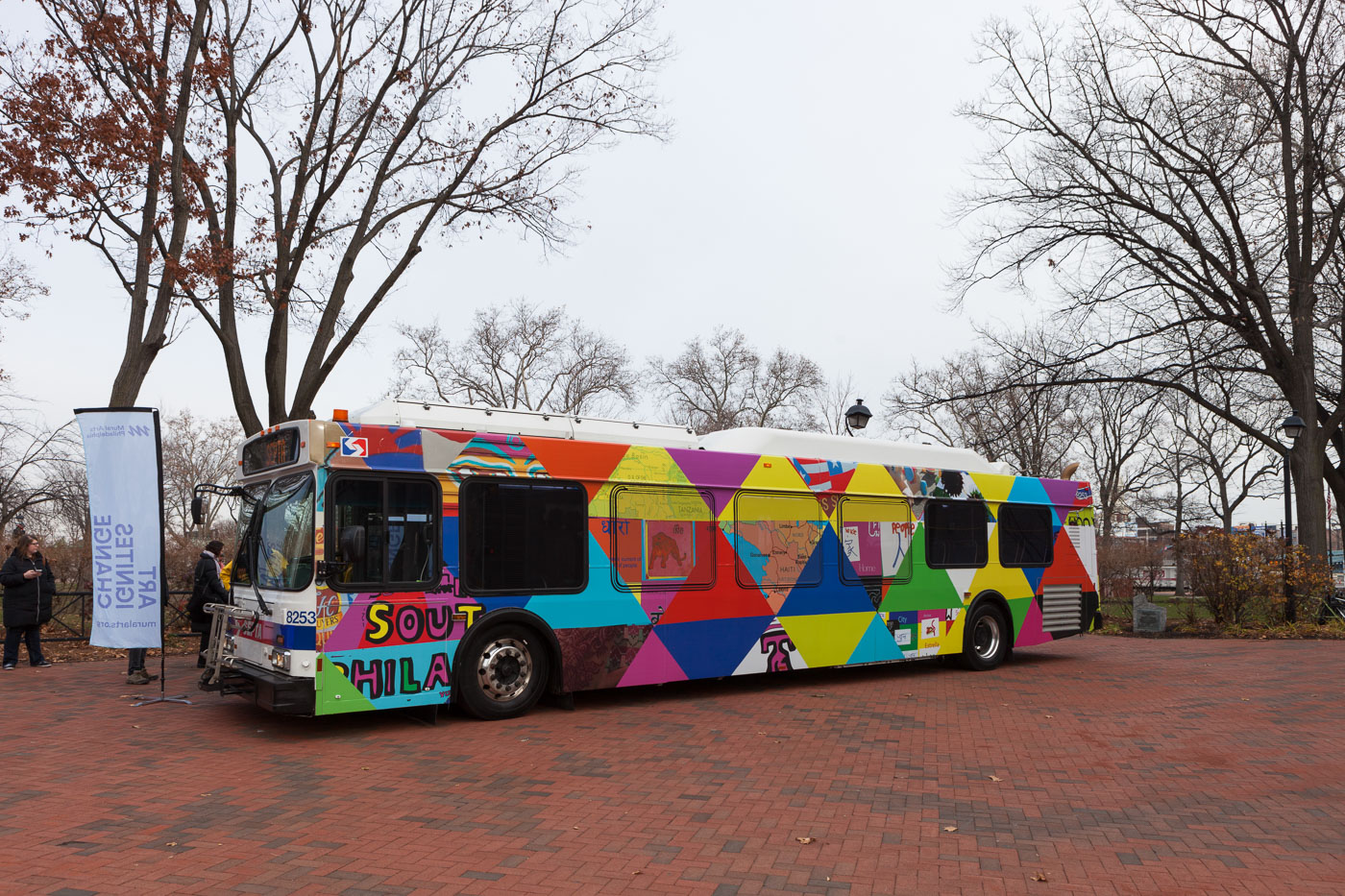
12 Mar SEPTA’s Urban Canvas: Elevating Commuter Experiences Through Artistic Collaborations
BY GABE CASTRO
This article is part of a column by Gabe Castro called “Reel Impact: From Screens to Streets.” The column explores contemporary film through conversations with Philadelphia-area community members and organizers. This column is funded with support from Bread and Roses Community Fund.
“We are all migrating together.” – Miss Jackie, SEPTA bus driver, for the 47 Stories project.
For many Philadelphians, public transportation is a necessity easily taken for granted; these routes that connect us to work, school, and home quickly become a part of everyday life. SEPTA (Southeastern Pennsylvania Transportation Authority), in conjunction with several organizations and artists, is working to transform our understanding of these commutes by reshaping them as connections to our communities and the environment around us. Multidisciplinary artist Anula Shetty’s Philly Daydreams seeks to humanize SEPTA by connecting the commuter to the frontline workers, while artist and activist team Shira Walinsky and Laura Deutch, through their projects 47 Stories and Getting to Green, have been working to highlight the existing veins of the city that allow our migrant communities to thrive and give Philly residents access to green spaces.
SEPTA is a powerful tool that provides access to the diverse history and culture within Philadelphia. Accessibility and equity have been key issues since the early onset of the program when they used horse-drawn trolleys. February 22, 2024 marked the 185th birthday of civil rights hero Octavius Catto, who helped desegregate those trolleys in 1867. Although there are still issues of equity and accessibility with our public transportation system, SEPTA does provide essential services to people from all over the city. While SEPTA is currently facing drastic cuts that could impede the progress and sustainability of the transit system, collaborating with artists to reframe local understanding can emphasize the importance of SEPTA as a connector in the city. It’s easy for commuters to be focused on delayed schedules, crowded cars, and temporary shuttle buses. If we can step back from the day-to-day and see how the system connects us to neighbors, cultures, and the natural world around us, we might be more able to appreciate the system we have while envisioning an even better future.
Philly Daydreams with Anula Shetty
Philly Daydreams: Stories in Transit is an augmented reality public art project by Anula Shetty about SEPTA. Forman Arts Initiative and Mural Arts Philadelphia partnered to create a Public Works residency program which places local artists with public programs and agencies to strengthen connections between these government organizations and the people they serve. Shetty was the inaugural artist in this Public Works program–she was placed at SEPTA and immersed herself in it, riding along with drivers and attending railroad worker training. Drawing from her immigrant experiences, Shetty aimed to bridge the connection between SEPTA workers and commuters, envisioning a way for riders to delve into the unique essence of each neighborhood during their transit. She shares, “Seeing all these distinct neighborhoods flashing by as you’re traveling around the world. On the El and on the buses, there are all these amazing neighborhoods in Philly. How amazing would it be if you could just jump right into the heart of what makes this neighborhood special.”
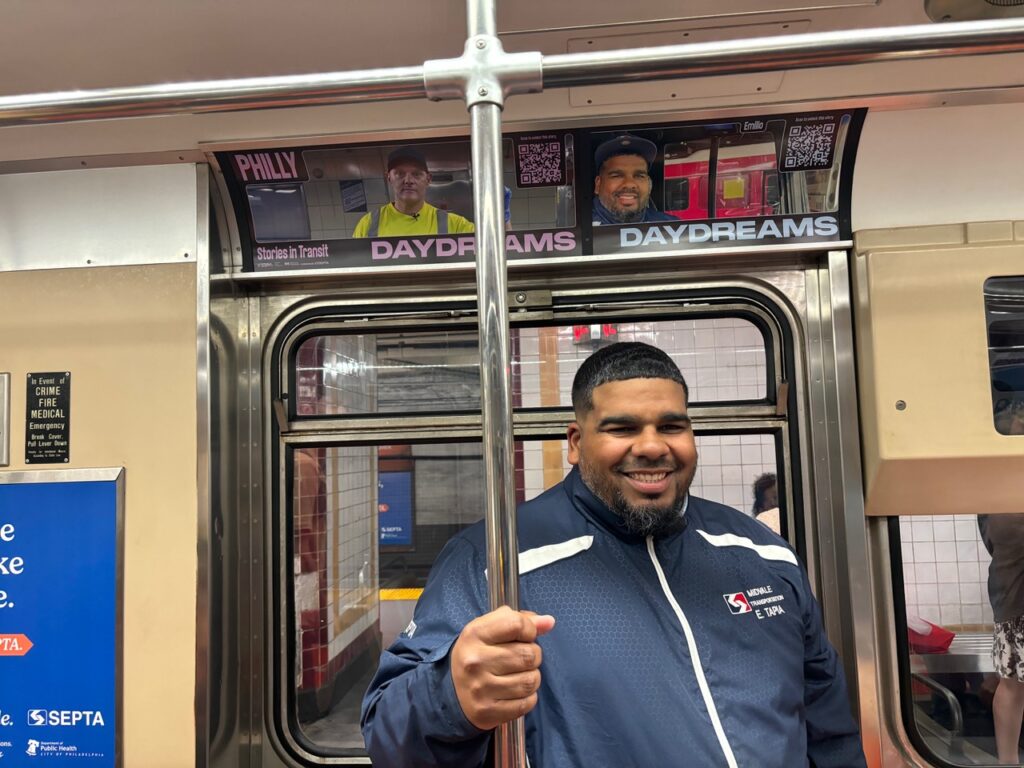
Philly Daydreams features short interviews with SEPTA workers and commuters, exploring the impact of SEPTA on their lives and their daydreams during transit. Accessible via QR codes on SEPTA, these stories provide glimpses into the lives of those sharing the same train cars, trolleys, and buses. One example includes Emilio Tapia, a bus driver who finds meaning in supporting his riders who don’t speak English. He speaks Spanish, and in these moments when he can assist them, he feels most connected to his community. For Shetty, this video has an extra element of connection, as Tapia had been a student of hers in a video workshop when he was 17 years old.
In another vignette, Catzie Vilayphonh shares her family’s migration history from Laos, emphasizing SEPTA’s role in connecting them to various places. She uses SEPTA to stay linked to her community, commuting from North to South Philly for work in the Southeast Asian Market. Reflecting on the importance of public transportation for immigrants, Catzie highlights how it enables them to navigate their new home, fostering connections between home, work, and community. Currently, SEPTA is looking to rename their lines to make them more accessible. In an article on Philadelphia Today, they explain, “Replacing long, inconsistent names with simple letters and colors eliminates language barriers, streamlines the entire system, and creates consistency that supports easy navigation.”
The Philly Daydreams project included an in-person element at SEPTA’s Oculus space beneath Dilworth Plaza, adjacent to Philadelphia City Hall. This circular, underground room features a dome revealing the sky above. Anula Shetty chose this space for its symbolic significance, as it was originally designed as a central point of connection for commuters using the underground tunnels to access the different transit options. Its location at City Hall made it a transportation hub where people could navigate their way to the Broad Street Line, Market-Frankford Line, and the trolley routes. It has been closed since the pandemic due to staffing and sanitation concerns. The circular area allowed for a full activation, featuring moving clouds in the dome above and showcasing vignettes on subway tiles. The underground location amid transportation added to the immersive experience, creating “beautiful accidents” that enhanced the viewer’s experience. “Some of the accidents were related to the soundtrack. You would be sitting and watching Ursula Rucker’s beautiful poem about how sometimes she dreams. And in the middle of the poem, she’s talking about traveling back and forth on trains. And then you hear the sound of a train rushing by,” Shetty shares about the experience. The mosaic installation, connecting commuters to story, space, and other people riding SEPTA, enhanced viewers’ experience with the transit system. Keep an eye out for these Philly Daydreams interviews that can still be found through QR codes throughout SEPTA.
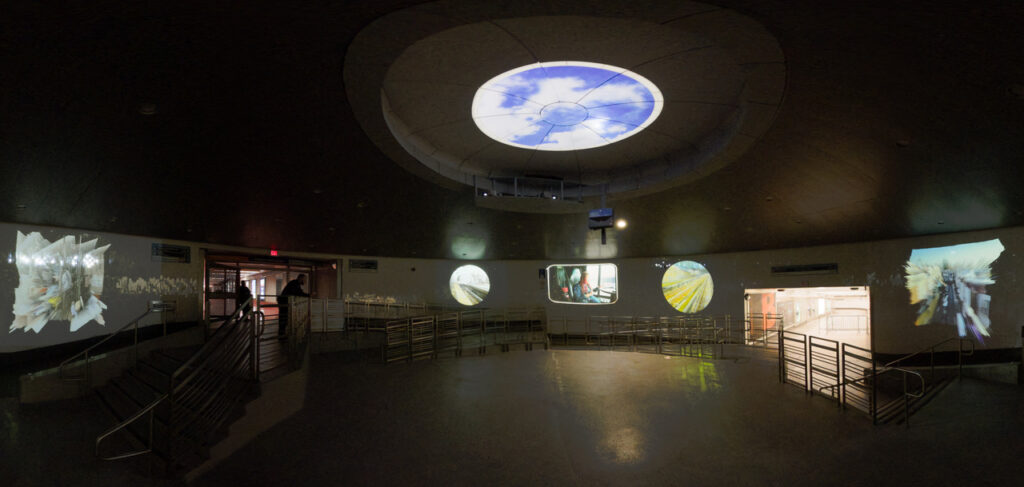
Getting to Green and 47 Stories with Shira Walinsky and Laura Deutch
Artist duo Shira Walinsky and Laura Deutch began their artistic exploration of Philadelphia’s public transit system with the interactive event 47 Stories during a 2016 Audio Festival in collaboration with Mural Arts Philadelphia. Focused on the 47 bus, a vital north-to-south route connecting diverse communities, the project aimed to unveil the rich tapestry of stories along the way. Walinsky and Deutch highlighted the route’s expansive diversity, connecting immigrant communities from end to end, such as the Cambodian community in South Philly to the Colombian communities in the north. This bus route has been acknowledged in different ways for its role of connecting these communities including a recent film, La Guagua 47, about the ways the bus connects communities of Hispanic and Latin descent and featuring a colorful display of the people who rely on this route. Learn more about Ritmo Lab’s work on La Guagua 47 in the organization spotlight.
Additionally, an event had participants riding the 47 bus to its endpoint, with organized stops prompting interaction with local vendors, community members, and organizations representing different communities along the route. The interactive 47 Stories event featured an audio playlist by Deutch for commuters, fostering connections during their journeys through interviews with other commuters and SEPTA employees. Attendees of the tour would listen to the playlist as they rode along to the planned destinations, creating a soundtrack to their journey. The audio is still active and available, and Deutch encourages riders to listen to the playlist on their own commutes. The project also included a map designed by Walinsky that brought the points of interest along the route to life.
Walinsky emphasized in an interview with cinéSPEAK the potential for connection along this culturally rich route, highlighting the myriad of cultures, languages, and experiences that commuters may overlook without guidance. “The project came in 2016 as Trump was elected, and it came from thinking about migration and immigration, and that kind of visibility. When you ride the bus, there are 100 stories on that bus, and you don’t know the stories you pass by on your route to work or home. You don’t know what you’re missing.”
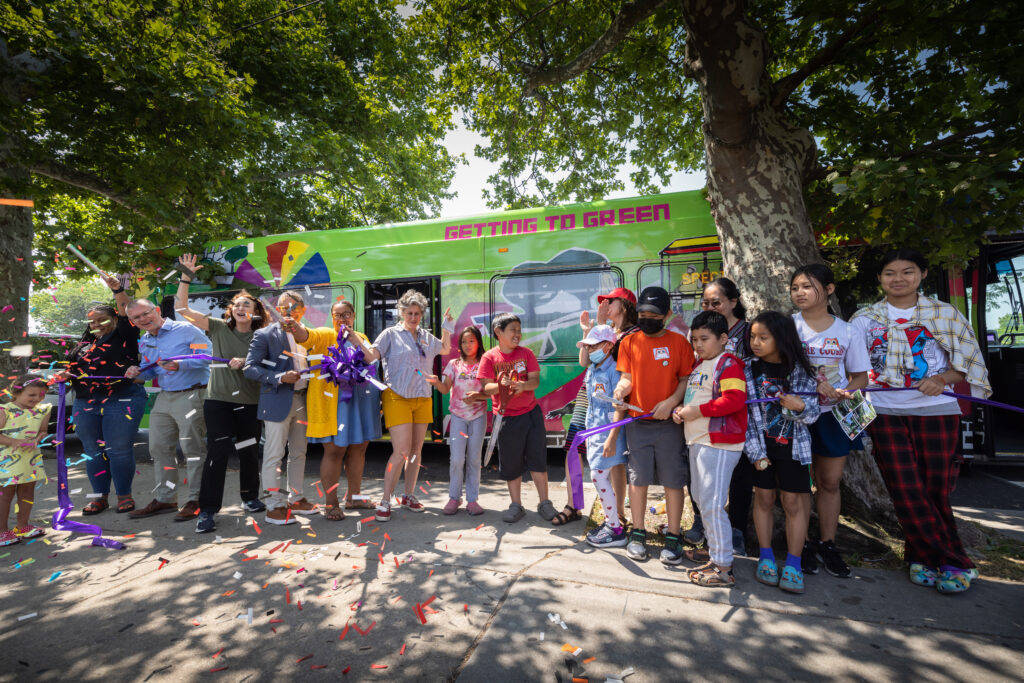
Walinsky and Deutch continue their energetic engagement with commuters through a new collaboration with Delaware Valley Regional Planning Commission (DVRPC), Mural Arts, and SEPTA called Getting to Green. In response to the post-pandemic need for community reconnection, they are developing a map highlighting routes to Philadelphia’s green spaces. This interactive program features eye-catching posters in bus shelters, hand-drawn maps, and curated tours that will guide members to natural areas using everyday transit routes. One successful tour, involving 50 people partnered with the migrant support agency SEAMAAC, utilized the 7 bus along the “river to river” route from 4th Street and Oregon Avenue in South Philly to 29th Street and Pennsylvania Avenue for access to Lemon Hill, a family-friendly wooded area. The aim is to emphasize existing tools for repeat visits to these spaces, recognizing the crucial role of green spaces in mental health and community wellness.
Amidst violent crime and unrest in the city, knowing how to get to these places can alleviate some existing tensions and stresses. Similar to the 47 Stories project, Getting to Green also features a media element. This project includes videos created by Deutch featuring commuters and transit workers alike. The Bus Stop Stories videos ask commuters about their daily journeys while informing them of hidden gems in the city. Getting to Green is part art and part education, inspiring commuters to make return trips to these green spaces and encouraging riders to take in the many stories this city has to offer right outside the bus windows.
The Getting to Green project’s map is expected to be made available this summer. They will also be hosting a show at Cherry Street Pier in April that will present all of the artwork that’s been created for the shelters along with the map, and will showcase the interviews with commuters and transit workers. Follow the project on Instagram (@GettingtoGreen.PHL) for more details.
A recurring experience for participants of these different art initiatives has been a renewed understanding and appreciation for SEPTA. For drivers and operators, there is more recognition of their hard work, humanizing a job often overlooked in the daily hustle. Riders, in turn, discover more about the routes, optimizing their experiences and deepening their appreciation for the existing connections facilitated by this access. Amid SEPTA’s transformations, including the Bus Revolutions (route changes), line renaming, and the upcoming removal of the Key card system, these art programs can foster better understanding from commuters and patience toward these evolving systems. At the core of each project is a shared aspiration among participants—both commuters and employees—to perceive the world around them. The aim is to discover concealed spaces, community hubs, green areas, and thriving neighborhoods visible just beyond the train windows.
*Featured Image: Image of the 47 bus with design by Shira Walinsky and Laura Deutch. Image Credit: Steve Weinik.
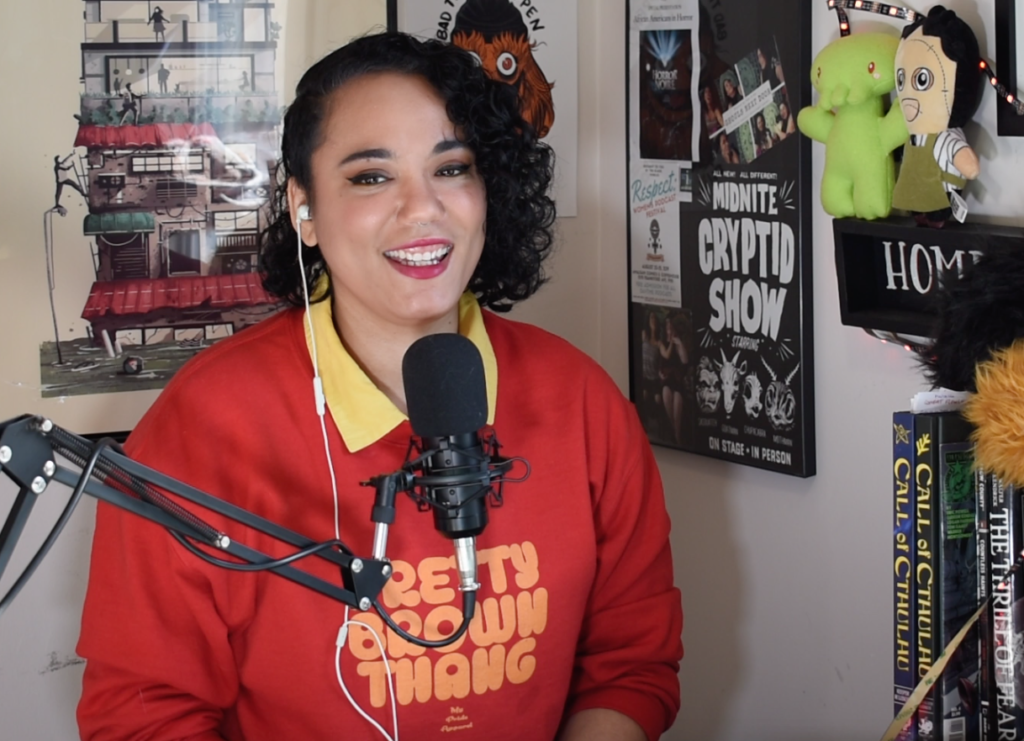
Gabe Castro is a Philadelphia-based Latiné multimedia professional specializing in the horror genre. Gabe believes media can be used as a tool to bring social change and works in all she does to create impactful and inspiring media. Gabe is a former cinéSPEAK Philly Beat Fellow.
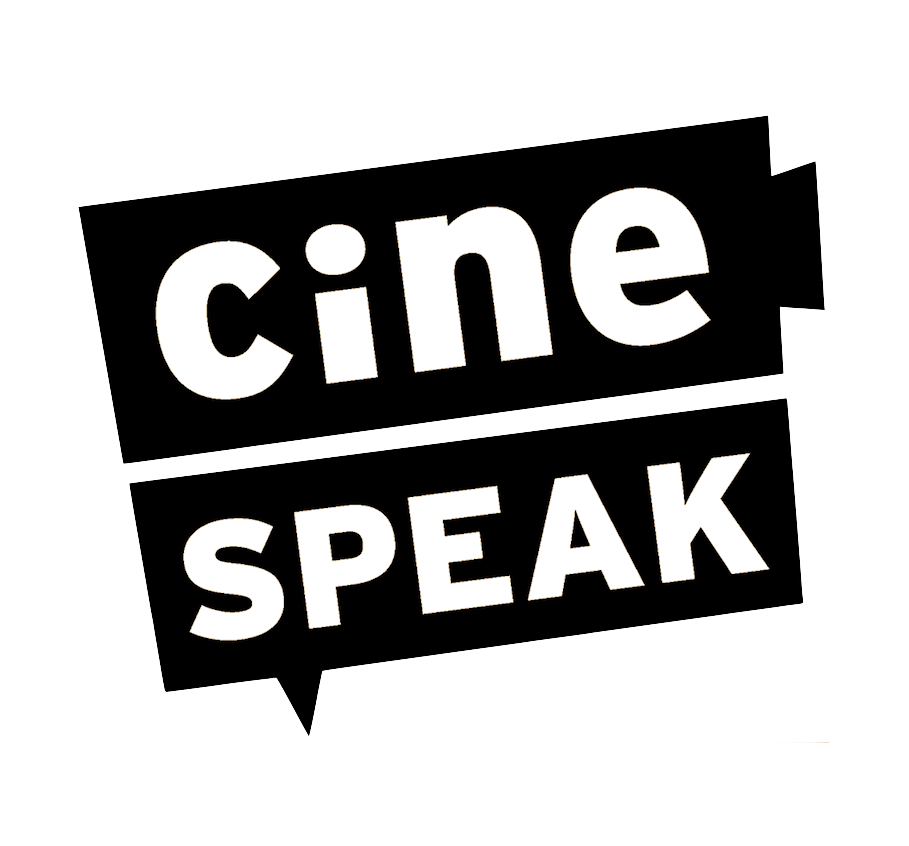
Sorry, the comment form is closed at this time.